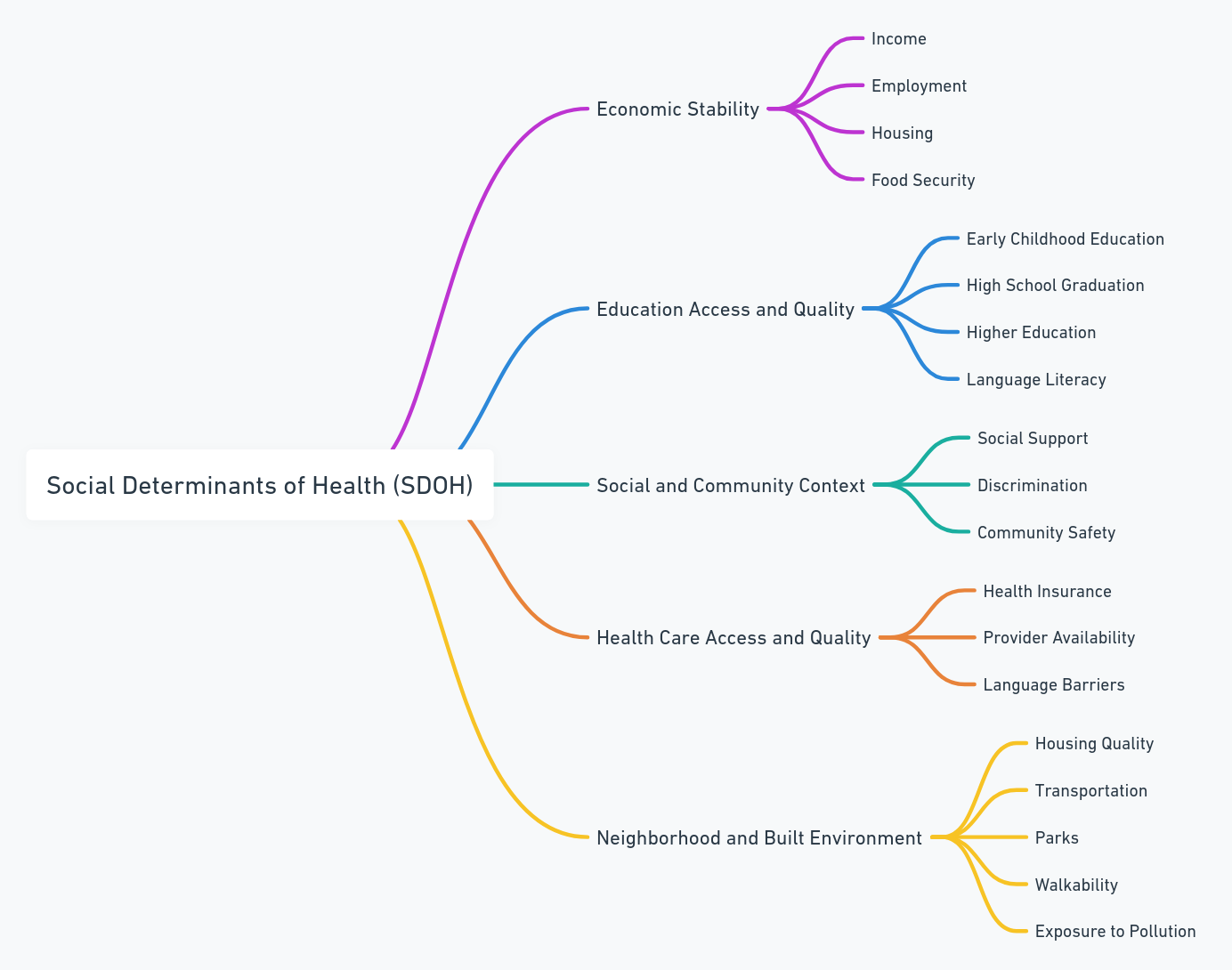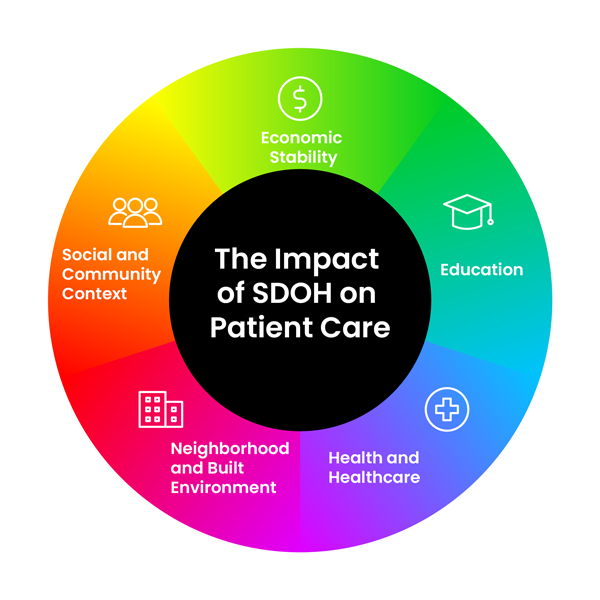
The Role of Social Determinants of Health (SDOH) in Patient Care
Introduction
The US healthcare system has long focused on treating illnesses and managing symptoms. However, a growing body of evidence demonstrates that health is influenced by factors far beyond the doctor’s office or hospital. These factors, known as Social Determinants of Health (SDOH), encompass the conditions in which people are born, grow, live, work, and age. They include economic stability, education access and quality, social and community context, health care access and quality, and neighborhood and built environment.
The significance of SDOH is undeniable. They play a crucial role in health outcomes, health disparities, and overall healthcare costs. In fact, research suggests that medical care accounts for only 10-20% of health outcomes, while SDOH account for a staggering 80-90%. This realization is transforming how to approach patient care.
What are Social Determinants of Health?
SDOH are the conditions in which people are born, grow, live, work, and age. They encompass a wide range of factors, including;
- Economic Stability – Income, employment, housing, food security
- Education Access and Quality – Early childhood education, high school graduation, higher education, language literacy
- Social and Community Context – Social support, discrimination, community safety
- Health Care Access and Quality – Health insurance, provider availability, language barriers
- Neighborhood and Built Environment – Housing quality, transportation, parks, walkability, exposure to pollution
The Impact of SDOH on Patient Care
1. Economic Stability
Economic stability is a significant determinant of health. Individuals with steady employment and sufficient income are more likely to afford healthcare services, nutritious food, and stable housing. Conversely, those facing unemployment or low income often struggle to access necessary health services and medications.
According to the American Public Health Association (APHA), people with lower income are at higher risk for chronic diseases like diabetes and heart disease due to limited access to preventive care and healthy food options
2. Education
Education is another critical factor. Higher levels of education are associated with better health outcomes, as they often lead to better job opportunities and higher income. Educated individuals are also more likely to understand health information and engage in health-promoting behaviors.
A study published by the National Bureau of Economic Research found that higher educational attainment is linked to lower mortality rates and better overall health
3. Social and Community Context
Social support and community engagement play a crucial role in health. Strong social networks can provide emotional support, practical help, and information, all of which contribute to better health outcomes. Conversely, social isolation and discrimination can lead to stress and adverse health effects.
The CDC reports that social isolation significantly increases the risk of premature death, comparable to smoking, obesity, and physical inactivity
4. Health and Healthcare
Access to healthcare services and health literacy are fundamental to managing health conditions and preventing diseases. Barriers to access, such as lack of insurance, high costs, and transportation issues, can lead to unmet health needs and worse health outcomes.
The Kaiser Family Foundation found that nearly one in four Americans have skipped necessary medical care due to cost concerns
5. Neighborhood and Built Environment
The environment in which people live can significantly impact their health. Safe neighborhoods with access to parks, healthy food, and good housing contribute to better health outcomes. Conversely, living in areas with high crime rates, pollution, and poor housing can lead to stress and health problems.
The U.S. Department of Housing and Urban Development reports that poor housing conditions, such as exposure to lead and mold, are linked to various health issues, including asthma and lead poisoning in children
What Healthcare Providers Can Do
Addressing SDOH is a complex challenge that requires a multi-faceted approach. However, healthcare providers can play a crucial role in identifying and addressing SDOH among their patients. Here are some actionable steps;
- Screen for SDOH – Integrate routine SDOH screening into patient intake processes. Use validated screening tools to identify patients facing social risks.
- Connect to Resources – Partner with community-based organizations to provide patients with access to resources like food assistance, housing support, transportation services, and financial counseling.
- Coordinate Care – Adopt a team-based approach to care that includes social workers, community health workers, and other professionals who can help address patients’ social needs.
- Advocate for Policy Change – Healthcare providers can leverage their influence to advocate for policies that address the root causes of SDOH, such as affordable housing, equitable education, and fair employment practices.
- Leverage Technology – Innovative technology platforms like those offered by Salesforce Health Cloud and Snowflake can help healthcare organizations collect, analyze, and utilize SDOH data to improve patient care and population health.
Why should the pharma and home healthcare sectors be particularly concerned with SDOH?
- Medication Adherence and Efficacy – A patient struggling to afford their prescriptions or lacking transportation to a pharmacy is unlikely to adhere to their medication regimen. Similarly, a home healthcare patient living in an unsafe neighborhood may not receive consistent care. SDOH directly affects whether patients can access and effectively use the treatments we provide.
- Health Disparities – SDOH are major drivers of health disparities, the preventable differences in health outcomes between groups. According to the Centers for Disease Control and Prevention (CDC), people with lower incomes and less education tend to have poorer health than those with higher incomes and more education. By addressing SDOH, it reduces these inequalities.
- Rising Healthcare Costs – Poor SDOH often leads to more frequent hospitalizations and emergency department visits, driving up healthcare costs. A study by the Kaiser Family Foundation found that addressing housing instability alone could save Medicaid $2.7 billion annually. Investing in SDOH interventions can result in significant cost savings for the entire healthcare system.
The Pharma Industry’s Role
- Patient Services Programs (PSPs) – Pharma companies can expand PSPs to address not only medication costs but also other barriers like onboarding into therapies, transportation and food insecurity.
- Partnering with Community Organizations – Collaboration with local organizations can help connect patients with resources for housing, food, and transportation.
- Data-Driven Approaches – Analyzing SDOH data can help pharma companies tailor interventions to specific populations and measure the impact of their efforts.
The Home Healthcare Industry’s Role
- Holistic Care Plans – Home healthcare providers can integrate SDOH assessments into care plans, addressing not only medical needs but also social and environmental factors.
- Care Coordination – Home healthcare professionals can serve as critical connectors between patients and community resources.
- Advocacy – Home healthcare agencies can advocate for policies that support affordable housing, healthy food access, and safe neighborhoods.
Real-World Examples
- Pfizer’s “Get Healthy Stay Healthy” program – This program provides resources and support for patients with chronic conditions, addressing SDOH like healthy eating and exercise.
- UnitedHealthcare’s “Housing First” initiative – This program helps individuals with complex medical needs find stable housing, resulting in reduced hospitalizations and emergency department visits.
- Salesforce Health Cloud – This platform allows healthcare providers to track and address SDOH in a coordinated manner, leading to improved patient outcomes.
The Future of Healthcare – A Shared Responsibility
Addressing SDOH is not just a moral imperative; it’s a strategic business decision. By investing in SDOH interventions, it can improve patient outcomes, reduce healthcare costs, and build healthier communities.
Moving beyond treating illness and embracing a holistic approach to healthcare that recognizes the profound influence of social determinants. The future of industries – and the well-being of patients depends on it.


